Getting traffic to your WordPress site is only half the battle. The real challenge? Getting visitors to stick around and explore more of your content. We learned this the hard way when our first WordPress blog had amazing traffic but terrible engagement metrics.
Over the past decade, we’ve tested countless methods to keep visitors engaged across our WordPress sites. Through trial and error, we’ve identified which strategies actually work to increase pageviews and reduce bounce rates – and which ones are just a waste of time.
Today, we’re sharing our battle-tested playbook for turning casual visitors into engaged readers. These are practical solutions that have worked for thousands of WordPress users we’ve helped, regardless of their technical expertise or website niche.
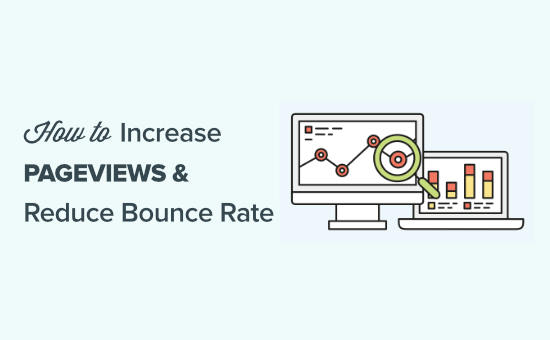
What is Bounce Rate?
Bounce rate is the percentage of visitors who land on your site and leave without continuing to a second page or without triggering any other event that GA4 tracks. A high bounce rate means that you can’t convince a visitor to stay on your page and take action.
A visitor can bounce from your site in a lot of ways.
- Clicking the back button
- Typing in a new URL
- Closing the tab or window
- The session times out (from hosting errors or being idle)
People leave websites all the time. It’s normal because that’s how people navigate the web. But, there is a difference between a good and bad bounce rate.
A good bounce rate means your visitors had a good user experience and found what they’re looking for on your site. A bad bounce rate means a lot of your visitors land on your site and leave quickly.
What is a Good Bounce Rate?
Good bounce rates will vary by your industry and the type of website that you have.
There are some general rules you can keep in mind when looking at your own data.
- Over 80% is a very bad
- Between 70 and 80% is poor
- Between 50 to 70% is good
- Between 30 to 50% is great
- Under 20% is generally a tracking error
There are a lot of reasons your bounce rate could be high. Luckily, most of these reasons can be fixed.
- Your site loads too slowly
- Your visitors are having a hard time navigating your site
- You have a poor design
- There aren’t any clear calls-to-action
There’s a lot you can do to improve your bounce rates and increase the total number of pageviews your WordPress site receives.
Getting Started
Before you begin, you’ll need to know your existing bounce rate and average number of pageviews.
We recommend using Google Analytics with the MonsterInsights plugin. It’s the best analytics solution for WordPress used by over 3 million websites.
This lets you easily view your traffic and user data directly from your WordPress dashboard. As you implement the tips in this post, you’ll see your numbers improve.

For more details, see our guide on how to install Google Analytics in WordPress.
1. Speed Up Your WordPress Site
If you have a high bounce rate, then it’s easy to assume your content or website is to blame. But your visitors could be leaving before they’ve even had a chance to see your content.
If your site doesn’t load within 2 seconds, then most visitors won’t wait around. This applies to both mobile and desktop users.
Speeding up your WordPress site will improve your user experience, increase your total number of pageviews, and help with your WordPress SEO rankings.
First, you’ll want to run a website speed test, so you can see how your website is currently performing. For more details, see our guide on how to properly run a website speed test.
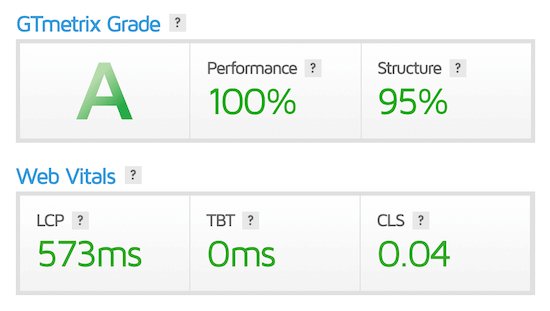
Once you know how your site is currently performing, you can start making your WordPress site faster.
Luckily, there are a ton of ways you can speed up your WordPress site performance.
For most websites, the biggest things that slow down their site speed are their WordPress hosting or improper WordPress caching configurations.
To help you fix your website speed, we have created an ultimate guide on how to boost WordPress speed and performance.
2. Improve Your WordPress Navigation Menus
Your navigation menu is one of the main ways visitors will navigate around your site. Most website owners don’t think twice about their navigation menus.
But, having a navigation menu that’s too complex or confusing can lead to higher bounce rates.
You want your navigation menu to be simple and help your visitors find exactly what they’re looking for.

We use a drop-down navigation menu to organize thousands of posts on the WPBeginner blog simply. Even when you have a content-heavy site, you should still organize your menus in a logical manner.
WordPress makes it easy to create menus and sub-menus across your WordPress site. For more details, see our beginner’s guide on how to add a navigation menu in WordPress.
3. Improve Your Internal Links in WordPress
Internal linking your content together is not only great for SEO, but it’s also one of the best ways to reduce bounce rate while increasing pageviews.
Internal linking is the process of linking from one page on your site to another.
For example, we can link to our best WordPress SEO plugin guide here in this sentence as our internal link.
Internal links are relevant links that enhance your existing content.
You can easily add internal links directly from your WordPress content editor.
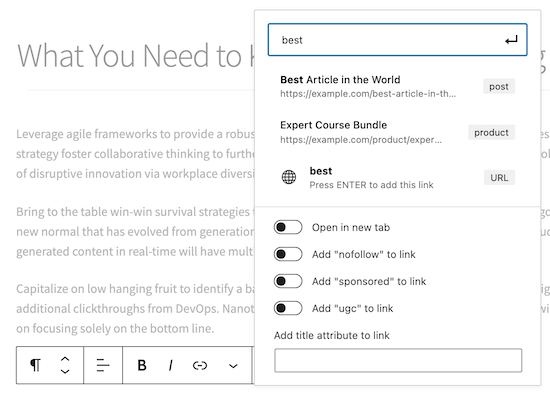
For more details, see our beginner’s guide on how to add a link in WordPress.
Note: Some of the additional options that you see in our screenshot above are added by the All in One SEO plugin for WordPress. We recommend using AIOSEO to improve your SEO rankings.
AIOSEO also has a Link Assistant feature to make internal linking easier to manage. It will automatically find internal linking opportunities in your content that you can apply in a couple of clicks.
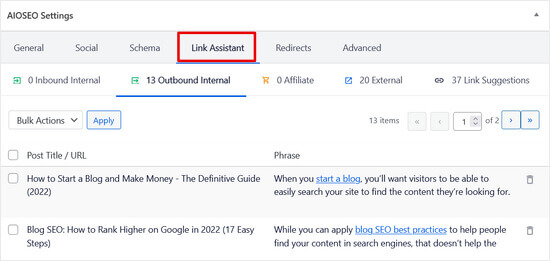
You can learn more about it in our list of the best internal linking plugins.
4. Add Internal Search to WordPress
Internal search lets your visitors search your site for the content they’re looking for, just like Google.
Often users will use your website search bar to find the content they’re looking for before leaving your site.
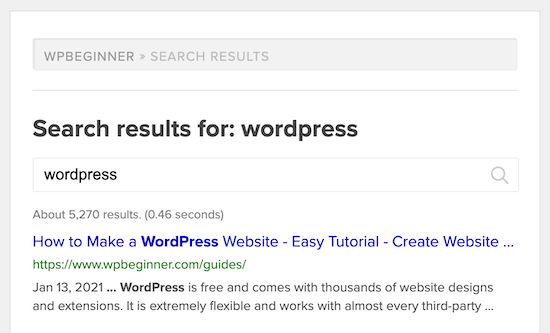
By default, WordPress has a built-in search widget. However, the results algorithm is pretty limited, which means users may not find what they’re looking for even when searching.
We recommend using a WordPress search plugin like SearchWP to enhance your visitors’ search experience. For other options, see our list of the best WordPress search plugins to improve your site search.
5. Open External Links in a New Tab
Linking out to other websites is also great practice. It helps you build relationships with other website owners and makes your content more valuable.
However, external links can make your visitors leave your site, which can increase your bounce rate.
The best way to fix this is by having your external links open in a new tab or window. That way, when a visitor clicks an external link, they won’t leave your website.
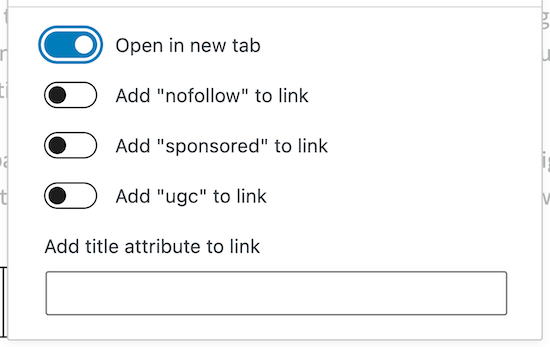
WordPress has the option to make your external links open in a new tab within your post editor. Any time you add a link, simply enable the ‘Open in new tab’ toggle.
For more details, see our guide on how to open external links in a new window or tab.
6. Add Related Posts or Popular Posts
One reason your visitors are leaving after reading a post is that you’re not showing them what to do next.
So, instead of sticking around to read more, they leave.
An easy way to remedy this is to add a ‘Related Posts’ or ‘Popular Posts’ section at the end of your post.
If a visitor reads to the bottom of an article, then you know they’re engaged and are enjoying your site. It’s time to encourage them to keep reading.
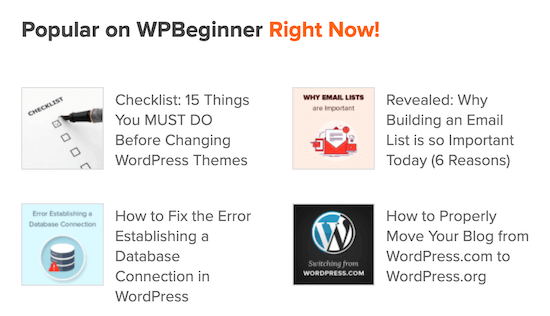
There are a lot of ways you can do this. We recommend using a WordPress popular posts addon from MonsterInsights.
This lets you easily add popular posts to WordPress and gives you control over the layouts.
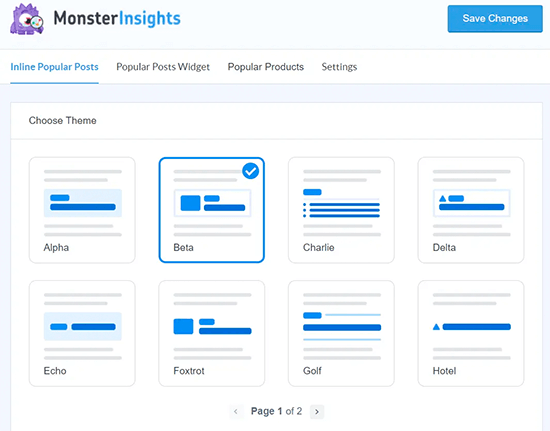
You can even use it to add inline trend posts within your blog content:

7. Make Your Content Readable
Most websites rely heavily on written content. If your content isn’t correctly formatted for the web, then this could be turning off your visitors.
There are a few key parts to making sure your content is easy to read.
First, make sure the text on your site is readable on all devices.
If readers have to zoom in or squint to see your text on mobile, then your font size isn’t big enough. For more details, see our guide on how to easily change the font size in WordPress.
Second, you need to format your content correctly. Readers tend to skim quickly instead of reading line by line. So, your content needs to match the way people read online.
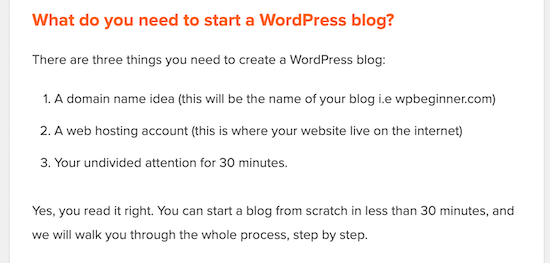
There are a few ways you can format your articles for the web the right way.
- Use subheadings to break up your content
- Make your paragraphs short
- Use bullets and lists when possible
- Embed videos and add images to your content
- Write in a conversational tone
8. Optimize Your WordPress Site for Mobile
Over half of all internet traffic comes from mobile devices. If your website isn’t optimized for mobile, then you’re delivering a poor experience for many visitors.
If your bounce rate is high and you haven’t optimized for mobile, then this could be why.
The best way to see if your site is optimized for the mobile web is by using Google’s Mobile-Friendly Test.
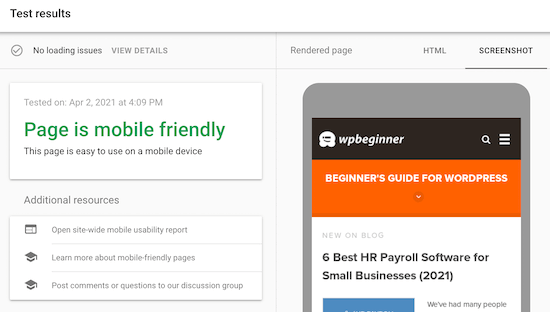
All you have to do is enter your URL, and you’ll get a report that’ll show you how you can optimize your website.
The easiest way to ensure your site is optimized for mobile is by choosing a responsive WordPress theme. A responsive WordPress theme will automatically adjust itself to your visitors’ screen size.
So, your WordPress site will look good on mobile, tablet, and desktop devices.
We’ve compiled a list of the best responsive WordPress themes.
Using a responsive theme makes it easy to optimize for mobile. All you have to do is install and activate the theme, and your site will be mobile-friendly.
There are also ways you can preview and edit the mobile version of your website, so you can make sure it looks great on mobile.
For more details, see our guide on how to preview the mobile version of your WordPress site.
9. Use WordPress Popups the Right Way
Popups can be a great way to grow your email list. But, they can negatively impact the user experience if they’re not used the right way.
You’ve probably been to a website where you were bombarded with popups. When all you were trying to do was read the content.
Instead of creating a poor experience, you can create popups that’ll display as visitors are leaving your site.
You can either let them go or try to convert them into a subscriber.
The easiest way to do this is using OptinMonster. It’s the best lead generation software on the market, used by over 1.2 million websites. We were able to use OptinMonster to grow our email list by 600%.
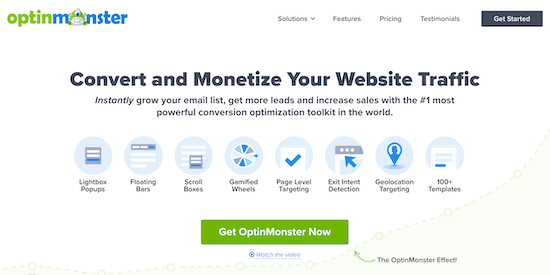
You can use the Exit-Intent® technology to display popups when visitors are thinking about leaving your site. Offer them an incentive to stay on the site or sign up for your email list.
There are also advanced targeting features, so you can create and display popups that are highly relevant to your visitors. For example, you can make pop-ups appear for only users who found your site via search engine vs a social network.
For more details, see our guide on how to build your email list with OptinMonster in WordPress.
10. Create a Custom 404 Page in WordPress
A 404 page is what your visitors will see if they come to your site via an invalid link. The page won’t be created on your site yet, so they’ll get an error message instead.
The goal of a 404 page is to redirect visitors to the content they might find helpful, instead of hitting the back button and leaving your site.
Depending on your WordPress theme, your standard 404 page might already list your pages, categories, or posts. But, this still leaves a lot of room for improvement.
The goal of your 404 page is to give your visitors relevant information, so they can find what they’re looking for and stay on your site.
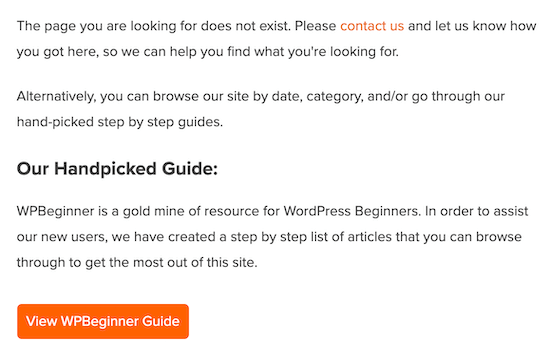
You can get creative with your 404 page. Some websites use humor, while others provide visitors with a helpful search tool.
The easiest way to create a custom 404 page is by using the SeedProd plugin.
For more details, see our guide on how to easily track 404 pages in WordPress.
11. Improve Your WordPress Sidebar
If your WordPress blog has a sidebar, there’s a lot you can do to optimize this space. For example, you can add things like popular posts, email signup forms, display ads, and even Instagram photos.
However, since your goal is to reduce bounce rate and increase your pageviews, you should include helpful resources that link to other areas within your site.
We maximize our sidebar and direct our visitors to other popular resources on our site. As you scroll down the page, you’ll find images that link to detailed tutorials, a search bar, and useful WordPress guides.
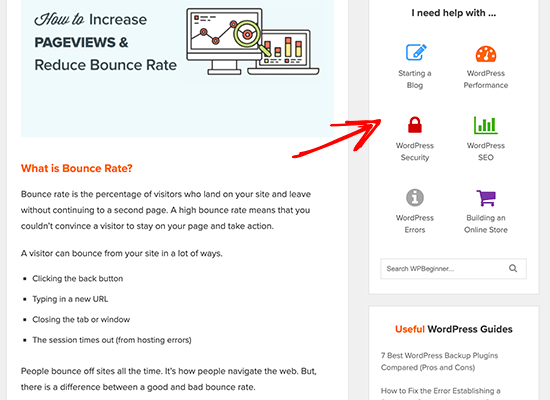
Note, if your site doesn’t use a sidebar, then use the rest of the tips in this post to optimize your website.
12. Show WordPress Post Excerpts on Your Homepage
If your homepage contains your latest blog posts, then you can turn these into excerpts instead of entire posts. This helps your website in two ways.
First, it decreases the time it takes for your page to load. Second, it helps increase your pageviews by giving your visitors more options to find the right content.
Our homepage gives readers the chance to check out our latest blog posts, and the newest one shows a post excerpt.
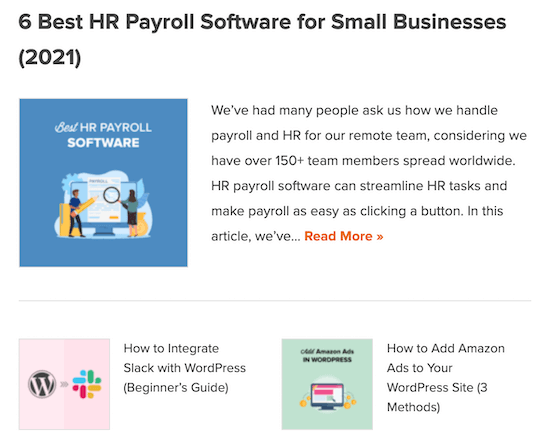
Our blog page lists 10 posts, all with post excerpts, and read more links.
You can add post excerpts to multiple locations across your WordPress site.
For more details, see our guide on how to customize WordPress excerpts with no coding required.
Final Thoughts to Increase Your Blog Pageviews and Lower Bounce Rate
Over 70% of people abandoning your website will never return. This is why it’s important that you have a way to contact them after they leave, so you can get them to come back.
The best ways to do that are to use OptinMonster’s Exit Intent® technology to give them a reason to stay on your site, create an email newsletter, and add web push notifications to your website.
Each of these will help you increase your website pageviews and overall traffic.
You can also see our ultimate guide on how to increase blog traffic with 27 proven tips.
We hope this article helped you increase pageviews and reduce bounce rates in WordPress. You may also want to see our guide on how to track SEO changes on your WordPress site and our expert pick of the best online content optimization tools for WordPress.
If you liked this article, then please subscribe to our YouTube Channel for WordPress video tutorials. You can also find us on Twitter and Facebook.





Olaf
Everything you need is written down in one place. I think it’s best to start with content and design since many people rely on first impressions. This makes the first paragraph and the look of the site crucial. It’s a good idea to keep the first paragraph short, perhaps even separated by a graphic, to break the feeling that there’s too much text to read. Internal linking is also highly effective; it directs readers to more content and practically prevents them from easily leaving the site because they keep finding other interesting sections. Primarily, though, it’s essential to focus on what the user sees first. A pleasant, uncomplicated, nicely colored layout, a welcoming first paragraph, and an introductory image. I believe these elements make a significant psychological impact.
Moinuddin waheed
People first content is the key to have reduced bounce rate.
Reading so many articles on different platforms, I have realised the
most successful blogs are the ones which makes the content really really helpful
for users.
They use simple and easy to understand language, they make easy navigation,
make internal linking of simialr articles and gives related posts and popular posts
at the end. This helps users to get indepth insights regarding a particular query.
Seeing the recent and frequent changes in google algorithms, it is always good
practice to create user first content.
Dayo Olobayo
Absolutely! User-centric content is king. You’ve hit all the important points: clear language, smooth navigation, and relevant internal linking. These elements not only reduce bounce rate but also keep visitors engaged and coming back for more.
Jiří Vaněk
Content isn’t everything. You can have the best, highest-quality content, but if it’s not well-presented visually, many people will leave without reading it. By this, I mean paragraphs, headings, navigation, table of contents, and more. Many people might also be intimidated by a large amount of information and won’t even start reading the article before leaving. So it’s important to think not only about the content, which is definitely very important, but also about the presentation, making it user-friendly and encouraging them to read.
Peter Iriogbe
To keep people on your website, make sure it works well on all devices and is easy to use. Write content that really helps visitors, putting their needs first. While getting links is good, I think the most crucial thing is making your content user-friendly and your website easy to navigate. Doing this makes visitors stay longer, and that’s what we want to achieve – keeping them around and lowering bounce rates.
Dennis Muthomi
That is well said!
To build on your point:- about making websites easy to navigate, I’ve found that simple tweaks like answering the user’s query from the first paragraph satisfies a user’s search journey can work wonders.
I always give my readers what they want right from the beginning of the post, it reduces the bounce rate and that sends signals to Google that my content is helpful, well… traffic is not that high but it improved
Mrteesurez
This is infact an incredible post.
Implementing these points stated above will definitely increase your chances of having users stay more on your website.
The more they stay, more the they scroll and discover new contents or other contents that might lead to sales.
WPBeginner Support
Glad you found our post helpful
Admin
Jiří Vaněk
Linking to previously written articles works great for me to increase pageviews. I am trying to incorporate more links into the text. For example, I created a dictionary of terms and each term has its own article. I can use this later in the text, where if any of the concepts appear, I can refer to the explanation using the dictionary.
WPBeginner Support
You can certainly use that approach
Admin
Moinuddin Waheed
Having reduced bonce rate is the key performance of any website as it increases visitors interaction and engagement with the content.
These are very practical insights to better the bounce rate and have the visitors love our content and stay on the website for long-time.
is there a concept of bounce rate for individual blog posts as well or it is just for the website or blog as a whole?
WPBeginner Support
It is normally tracked for a site as a whole but you can track it for certain pages if you wanted to see if a page was the source of a higher bounce rate.
Admin
Swarnambal John
Very informative article. Thanks for sharing.
WPBeginner Support
Glad you found our article helpful
Admin
Muhammad Bilal
tried these tricks but still bounce rate is 73% any suggestions ?????????
george
“you need to have exclusive Facebook content to make your Twitter audience feel special”
why twitter? is that the same?
aashish
No results after following the Steps/Data..
Vick
Tried almost all of these but the results are not forth coming. Bounce rate still at 98percent. Is there any other way out?
Lavie
Bounce rate increase if user do not find relevant information on your site that he/she searching for. Make sure your site has enough content with easy navigation also your site is ranking for right kind of keywords
Me
where do I find google analytics to download in my plugins? There are many different headings using this name. which do I use? I have Wordpress 4.1. Thanks for your help with this.
LE johns
Just want to express appreciation for the work you guys are doing. As a new blogger (three mo’s) the information your team has made available is absolutely invaluable. What you are doing is even more remarkable in that you are providing such a valuable service at no monetary cost. People like myself could never afford to pay for this kind of expertise. God bless you for what you’re doing. Again, it is deeply appreciated and definitely useful.
Dasangam Rahul
These tips helped me a lot.Previously my website was suffering with high bounce rate.with the help of this post,i could do some changes to my website.Now my website bounce rate reduced by 40%.Thank you very much for sharing this helpful post.
Diane Lynn
Loved this post. Reading the comments also proved helpful. Thanks!
Lawrence Abiodun
This is very wonderful and informative.
Definitely the best way to get more pageview is through Popular posts in the sidebar
Thanks you
Carlton
I would also add that reducing bounce rate is important for search engine optimization. Google & Bing tracks user engagement metrics on keyword searches, so if your bounce rate is steadily high, you are more likely to get ranked lower over time.
Sean G
Tried most of your tips and was stunned to see 15% instant next day improvement. More inside the post linking plus splitting long posts was golden.
Astro Gremlin
I improved my bounce rate by using a plugin similar to YARPP (but with less bandwidth use). The plugin is LinkWithin and it lets you show a thumbnail of photos linked to related posts. People tend to be intrigued by photos.
wpbeginner
Seems to be working fine here.
Christian
Hey, I tried that ‘Random’ button at the top of this page, which you named ‘Explore’. It is a broken link, and goes to a ‘Page Not Found’. Just thought I’d let you know! Also, great article!